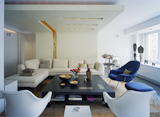Acclaimed Architect Gisue Hariri Invites Us Into Her Intimate Manhattan Loft
The right home is a reflection of who you are and how you live. No one knows this better than Corcoran, who has built its business on helping individuals find the home that matches their heart. This story is one of three interviews with acclaimed designers and architects whose homes reflect Corcoran’s "Live Who You Are" mission. Follow along for the entire series.
When her youngest daughter was ready for kindergarten, architect Gisue Hariri of Hariri & Hariri Architecture relocated from Union Square to the Upper East Side of Manhattan. She knew this neighborhood was the place for her family to settle, and she had a vision for her new home: something elegant and refined with minimal, thoughtfully placed artwork and furniture. She wanted it to express her individual taste, but also to be a comfortable haven for her family. Most importantly, she wanted a place where her girls could grow up, and that could evolve with them; a place that would reflect Hariri and her family, no matter what stage of life.
Hariri was determined that no area of the house was closed off, only to be used on special occasions. So her living and dining areas are an open space, separated from the kitchen by metal and glass doors that are rarely shut. On the occasion that they are, the doors still allow light and sound through, creating a sense of togetherness even with physical separation.
After a lengthy search, she found a suitable place: two adjacent units in a post-war, 1970s apartment building on Park Avenue. The location, a quiet enclave bordering Central Park and a number or New York’s finest art museums, was an inspiration for Hariri. "I believe every project should relate to its location," she says, and her renovation drew upon the sophisticated, tranquil, art-filled neighborhood surrounding the home. She combined the units into a large, three-bedroom, three-and-a-half-bath dwelling, and set out creating an elegant, open loft. Large windows allow the city to come in and for the apartment to expand outward, "greeting" the city. "The design of the apartment bridges the best of both the modern and traditional worlds, offering formal and casual, open and closed, elegant and comfortable, all in one place."
Hariri’s main concern was creating an environment that harbored closeness and openness, but still allowed for privacy. "How can we have a beautiful, elegant open space while keeping it neat and tidy, and give the kids their own space as well, without separation?" she recalls wondering. "Privacy doesn’t have an age. No matter how young or old you are, you want a little nook area where you can have a peaceful moment of reading or watching news." She created several of these small spaces for herself and her family throughout the home. "Everybody has their own little part," Hariri says.
On one side of the house lie the living room, dining room, and kitchen, a spacious, open area with small design elements—such as frosted glass sliding doors and quiet corners tucked behind pillars and planes—that foster privacy. Yet the loft layout keeps the space feeling accessible and airy, and all areas are multipurpose. "In a lot of homes, I realized, the entertainment areas are pretty much unused," says Hariri, who enjoys hosting guests often. "I think that’s a waste of space. I have multiple uses for each space, which is the key for today’s families."
"Design is a tool for seeing, and living, and being different."
Aside from adding an organic shape to the room, along with a subtle swath of pistachio green color, Hariri’s "folding planes" allow for wiring and lighting of the loft without lowering the whole ceiling area to accommodate the lighting fixtures. The planes gave her a way to drop the ceiling inconspicuously, avoiding harsh lighting over anyone’s head, creating a cozy, connected environment. "No one notices the dropped ceiling," she says.
The family’s bedrooms and private spaces are sacred. "I took part of the master bedroom for myself, right behind a column," Hariri shares. "I love it. I have my little chair and table and reading materials." The spot also houses her "wall of fame," where, when her daughters were younger, she featured a rotating assortment of their artwork, selected and voted on by the family as a whole. Hariri found that this practice fostered a pride in the girls’ artwork, "showing them how valuable art is, encouraging them to be objective and selective, and to edit their own work," she says.
This strong sense of style and taste, exemplified through her home, has been imprinted on Hariri’s daughters. "Your kids and your family learn to look and live differently when you are in a design environment," she explains. "Everything becomes precious. I see how tuned and keen my kids grew up to be. [Design] is a tool for seeing and living and being different."
Hariri and her husband have separate bathrooms, each with their preferred. He preferred a shower, but Hariri wanted a tub. "I love my bathroom," Hariri says, but emphasizes that she and her husband still get ready together. The two bathrooms share a hallway. "You can be in the same space and talk to each other still, get dressed together," she says.
In creating the space, Hariri treated her husband as if he were her client, submitting her ideas to him as she would on any other job. "His inputs were very valuable," she says. Together, they designed an apartment, "based on openness, quality, light, privacy, efficiency, and a lot of love." Now, with her oldest daughter a college graduate and her youngest away at school, the space still feels like home—a true reflection of the whole family.
Find the home that lets you live who you are on corcoran.com.
Published
Topics
Home ToursGet the Pro Newsletter
What’s new in the design world? Stay up to date with our essential dispatches for design professionals.








